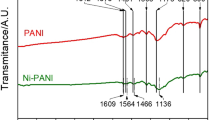Summary
Crystalline polymers, such as poly(ɛ-caprolactone) (PCL), poly(ethylene adipate) (PEA), and polyethylene (PE), were successfully grafted onto carbon black surface by direct condensation of terminal groups of these polymers with carboxyl groups on the surface using N,N'-dicyclohexylcarbodiimide as a condensing agent. The electric resistance of a composite prepared from these crystalline polymer-grafted carbon black drastically increased to 104–105 times of initial resistance in good solvent vapor of grafted polymer and returned to initial resistance when it was transferred into dry air. However, the change of electric resistance of the composite hardly observed in poor solvent vapor. These results suggest that these composite can be applied as a novel gas sensor.
Similar content being viewed by others

Author information
Authors and Affiliations
Additional information
Received: 18 February 1999/Accepted: 25 March 1999
Rights and permissions
About this article
Cite this article
Tsubokawa, N., Shirai, Y., Okazaki, M. et al. A novel gas sensor from crystalline polymer-grafted carbon black: responsibility of electric resistance of composite from crystalline polymer-grafted carbon black against solvent vapor. Polymer Bulletin 42, 425–431 (1999). https://doi.org/10.1007/s002890050485
Issue Date:
DOI: https://doi.org/10.1007/s002890050485



